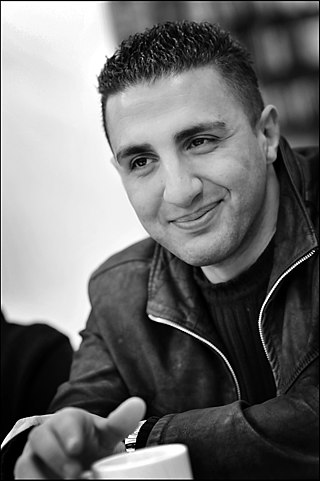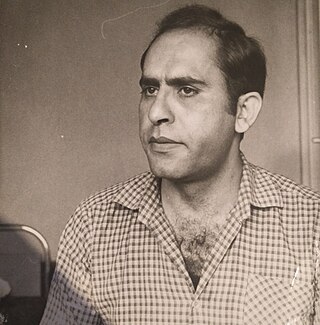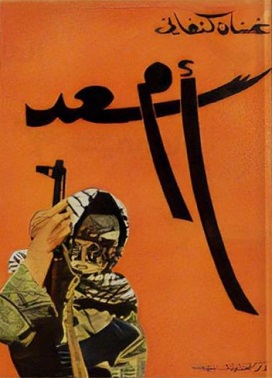
Ghassan Fayiz Kanafani was a prominent Palestinian author and politician, considered to be a leading novelist of his generation and one of the Arab world's leading Palestinian writers. Kanafani's works were translated into more than 17 languages.

Mahmoud Darwish was a Palestinian poet and author who was regarded as Palestine's national poet.
Saqr Abu Fakhr is a Palestinian writer living in Lebanon. He is a researcher and author specialized in Arab Affairs, with special focus on Palestinian affairs.

Samīħ al-Qāsim al Kaissy was a Palestinian poet with Israeli citizenship whose work is well known throughout the Arab world. He was born in Transjordan and later lived in Mandatory Palestine and Israel. Before the Six-Day War in 1967 he was mainly influenced by Arab nationalism; after the war he joined the Israeli Communist Party.
The 1988 Arab League summit held in June in Algiers, Algeria was the fifteenth Arab League Summit. The conference which has been held since 1964 had as focus, the topic of the First Intifada, an uprising by the Palestinians against Israeli occupation and the consequent upswing in Israeli-Palestinian violence.

Salma Khadra Jayyusi was a Palestinian poet, writer, translator and anthologist. She was the founder and director of the Project of Translation from Arabic (PROTA), which aims to provide translation of Arabic literature into English.

Najwan Darwish ; born December 8, 1978, in Jerusalem, is a Palestinian poet. The New York Review of Books has described him as "one of the foremost Arabic-language poets of his generation".
The El-Issa Family is an Arab Christian family that emerged from Jaffa, Palestine in the 20th century. The family is known for its "intellect, politics and literature", its members Issa El-Issa and his cousin Yousef El-Issa were among the first who warned about the Zionist movement in Mandatory Palestine. They were also among the first to promote Palestinian nationalism through their family's numerous newspapers and journals, most notably Falastin which was established in 1909. Other examples include Al-Asma'i, Alif Bā’ and Al-Bilād. The family now resides in Jerusalem; however, many family members are living in the diaspora, mainly in the surrounding Levantine countries and Western countries such as the United States, and Chile.

Izz Al-Din Manasirah was a Palestinian poet, critic, intellectual and academic born in the town of Bani Naim, Hebron Governorate, Palestine. Winner of several prizes as a cadet and an academic, he was a poet of the Palestinian resistance from the late 1960s on, and his name was associated with armed and cultural resistance. He was with such poets as Mahmoud Darwish, Samih al-Qasim and Tawfiq Ziad, or as they are collectively called, the "Big Four in Palestinian Poetry." He sang poems by Marcel Khalife and others and was famous for his poems "Jafra" and "The Green Kannah."
Suheil Kiwan is a Palestinian journalist and novelist. He won the Tawfiq Zayyad Institution Award in 2002 for his critical study titled ‘Ghassan Kanafani: Al-Jamal Al-Hazeen wa Al-‘Ata’ Al-Mutawahij'.

Abdul-Ghani Saeed Al-Karmi (1906–1974) was a Palestinian politician. In 1946, he and King Abdullah I bin Al-Hussein, founded the Hashemite Kingdom of Jordan. He served as the head of the Jordanian Royal Court. He was closely connected to King Abdullah the First, and one of the leaders of the Palestinian Arab Communist Party.
Hanan Awwad is a Palestinian activist, advocate, and poet. She is the president and founder of the Palestine section of the Women’s International League for Peace and Freedom (WILPF). Awwad has advocated for Palestine in front of presidents and ministers.
Nejmeh Khalil Habib is a Palestinian writer. She obtained a doctorate in philosophy from the University of Sydney in Australia. She was awarded a scholarship from the Australia Council for the Arts, as well as The Gibran Khalil Gibran International Prize issued by the Association for the Revival of Arab Heritage in Australia. In addition, she received a certificate of appreciation from the General Federation of Palestine Workers, Australia Branch.
Salim Qabain (1870–1951) was a Palestinian teacher, journalist, writer, historian, and translator. He is considered one of the most important Palestinian and Arab literary figures, especially in translation, and one of the first Arab translators who introduced the Arab reader to Russian literature, as he was nicknamed "The Dean of Translators from Russian."
The Sad Orange Land is a collection of stories by the Palestinian writer Ghassan Kanafani, it is the second stories collection. originally published in 1962, in which he attempted to convey the Palestinian character in the face of its fate both within the Palestinian interior, such as stories:
A Death in Bed No.12 is the first collection of stories written by Ghassan Kanafani. It was published in Beirut in 1961 with a short introduction by Ghassan that said: "I believe that the book should introduce itself, and if it fails to fulfill part of its writers' ambition, then the writer must simply accept it, as before- times and times- before the writers rips the stories to write them again, and like that, I push "A Death in Bed No.12" to find its own way, if it could find the beginning of the way". This collection of stories mainly explore the feeling of exile, which is portrayed through unilateral attachment to the past. The title comes from a story in the second part of the book. The revolves around a patient writing a letter to his friend Ahmed telling him about a death incident in bed 12, and about how each one of us hears about and perceives death differently. Ghassan Kanafani send in the introduction to an anonymous family whom their eldest son "Mohammed Ali Akbar" died away and alone in bed number 12.

Umm Saad is a novella written by fiction writer and journalist Ghassan Kanafani. The book discusses themes of war, patience, and resistance through a first point of view perspective. Upon its release, its political and social themes were generally praised.
Ahlam Bsharat is a Palestinian writer and poet, born in the village of Tammun in the Jordan Valley, and a trainer specialized in creative writing. She is an author of short stories, picture books, novels, and memoirs. Ahlam Bsharat is considered one of the most prominent names produced young people's literature and short stories in Palestine. She has written four novels for young people, dozens of children's stories, and two short story collections. Bsharat gained great attention after publishing the novel "My Kinetic Name is a Butterfly", a novel addressed to young people that reached the list of the 100 most important books for young people in the world in 2012, and the novel was reprinted in both Arabic and English. Bsharat's career as professional writer began in 2005, although she had this talent since the primary stage in her school. She composed stories and drew a visual narrative parallel to the text, so she acquired both skills at a young age.
Sheikha Helawy is a Palestinian writer and poet born into a Bedouin family in the village Dhail El E’rj, in the outskirts of Haifa. In 1989, she moved with her family to Jaffa. She is known as a prominent writer of Palestinian literature.
The Stolen Shirt is one of the first published stories by the Palestinian author, Ghassan Kanafani. It was published as part of his first short story collection, Death Bed No. 12 in 1958. The story won first place in a literary competition in Kuwait. In it, Kanafani looks at Palestinian suffering under the occupation through his employment of symbols.








